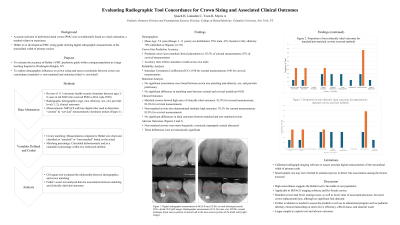Other
147 - Evaluating Radiographic Tool Concordance for Crown Sizing and Outcomes


Hung Quach, DDS (he/him/his)
Pediatric Dental Resident
NewYork-Presbyterian Kids
Columbia University College of Dental Medicine
Long Island City, New York, United States- CL
Christie Lumsden, PhD
Assistant Professor of Nutrition Sciences
College of Dental Medicine, Columbia University
New York, New York, United States - AM
Aaron Myers, DDS
College of Dental Medicine, Columbia University
- RY
Richard Yoon, DDS
Professor of Dental Medicine at CUMC
College of Dental Medicine, Columbia University
New York, New York, United States - CL
Christie Lumsden, PhD
Assistant Professor of Nutrition Sciences
College of Dental Medicine, Columbia University
New York, New York, United States - RY
Richard Yoon, DDS
Professor of Dental Medicine at CUMC
College of Dental Medicine, Columbia University
New York, New York, United States
Presenting Author(s)
Co-Author(s)
Research Mentor(s)
Program Director(s)
Purpose: To validate stainless-steel crown (SSC) prediction models by Helder et al. (2022)—previously reported achieving 93% accuracy with coronal and 88% cervical measurements—and explore demographic influences on sizing and correlations between matched/non-matched crowns and clinical outcomes.
Methods: Electronic health records (n=111) at Columbia University’s teaching clinic were reviewed for restorative appointments (charted with code D2930) from 2020-23. Data abstracted included radiographs, demographics, postgraduate level of restorative provider, and clinical outcomes (e.g., fit, seating issues, resorption). Measurements followed Helder et al.'s protocol using MiPACS software and were compared to model predictions. Crown matching was evaluated dichotomously (matched vs. non-matched). Chi-square tests assessed associations between patient demographic and provider characteristics on prediction accuracy. Fisher’s exact tests analyzed associations between matching and clinical outcomes (e.g., size, seating, abscesses, etc.).
Results: Children averaged 5.9 years of age (range: 3–11). Over half were male (59:41%, n=66), with 70% (n=78) identifying as Hispanic. Predicted crown sizes matched clinical placements in 92.5% of coronal and 87% of cervical measurements. No significant associations were found between matching and ethnicity, sex, or provider proficiency. Non-matched crowns were more likely oversized, improperly seated, or documented with abscesses. ICC values were 0.98 (coronal) and 0.96 (cervical).
Conclusion: The prediction tool reliably matched crowns with no significant demographic influences, though sample size may have limited power to detect associations. Findings suggest non-matched crowns may be more prone to complications, warranting further evaluation in a larger sample.
Identify Supporting Agency and Grant Number:

.jpg)